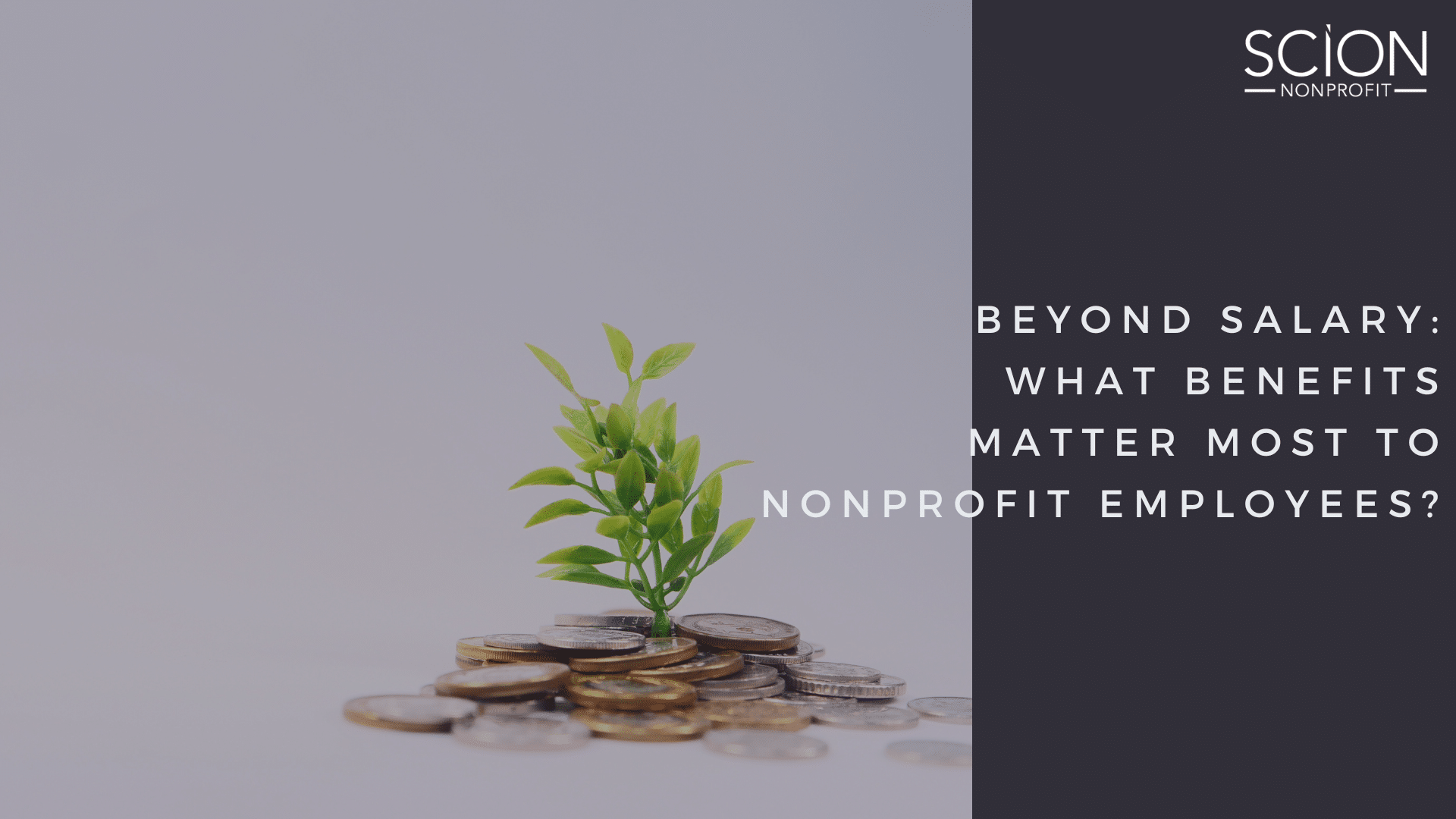
05 Feb Beyond Salary: What Benefits Matter Most to Nonprofit Employees?
With how competitive today’s labor market is, attracting and retaining top employees is a constant challenge for any organization. For nonprofits, where salaries may not always be as high as the for-profit sector, offering a competitive compensation package becomes even more critical. In this article, we dive into the unique needs of nonprofit employees, explores the types of perks they value most, and provides strategies for creating a benefits package that positions your organization for success in the race for top talent.
What Are Employee Benefits?
Employee benefits encompass a wide range of programs and services offered by employers to supplement salaries and enhance employee well-being. Here are some common types of benefits:
- Health Insurance: This is a core benefit, offering financial protection for medical expenses for employees and their families. Options might include group health insurance plans, dental and vision insurance, and HSAs or FSAs.
- Retirement Savings Plans: Providing retirement plan options like 401(k) plans with employer matching contributions helps employees secure their financial future and plan for life after their career.
- Paid Time Off: This includes vacation days, sick leave, personal days, and holidays. Generous paid time off policies enable employees to recharge and maintain a healthy work-life balance. Some companies have started offering unlimited PTO options to attract more talent.
- Life Insurance and Disability Insurance: These offer financial security to employees and their families in case of unforeseen circumstances.
- Wellness Programs: These programs include initiatives promoting employee health and well-being, such as stipends for gym memberships, fitness challenges, and on-site health screenings.
- Professional Development: Offering tuition reimbursement, skill-building workshops, and leadership training opportunities demonstrates investment in employee growth. This is a major attraction point for younger workers who want to grow in their roles.
- Work-Life Balance: Flexible schedules and work arrangements such as hybrid or remote work environments, childcare assistance, and student loan repayment programs can significantly reduce employee stress, as well as improving employee morale and well-being.
- Employee Assistance Programs (EAPs): EAPs offer confidential counseling and support services for employees facing personal or work-related challenges. This can be a great way for employees to address their mental health and can have a positive impact on their well-being.
Why Employee Benefits Matter
Competitive benefits packages can offer a variety of advantages, especially for nonprofit organizations. They can help attract top talent, making your organization stand out in a competitive job market and attracting highly qualified and mission-driven candidates. A great package makes employees feel valued and supported. This makes it more likely that they will stay with the organization, reducing costly turnover and training burdens.
By having a strong package, you are demonstrating your commitment to employee well-being, which leads to more positive and productive work environment. This can also help foster trust and loyalty in your brand, making your organization a more attractive place to work for candidates.
What Makes Nonprofit Employee Benefits Different from Other Industries?
While core benefits like health insurance and retirement savings are important across all industries, nonprofit employees often have distinct priorities. Many are driven by a desire to make a positive impact on the world, and their ideal package will reflect that. Some of the main differences between nonprofit and for-profit packages include:
- Mission Alignment: Nonprofit employees typically seek benefits that align with their organization’s mission. This can include tuition reimbursement for social work degrees, volunteer time off, or matching donations for charitable contributions to relevant causes.
- Work-Life Balance: Burnout is a significant concern in the nonprofit sector. Perks that promote work-life balance, like flexible work arrangements, generous paid time off policies, and childcare assistance, are highly valued.
- Affordability: Nonprofits may have tighter budgets for things like health plans than for-profit companies. Cost-effective benefit options like Health Savings Accounts (HSAs) or wellness programs can be attractive to employees looking to manage healthcare expenses and medical coverage.
Are Nonprofits Required to Offer Benefits to Their Employees?
Federal law does not mandate that nonprofits provide health insurance or other benefits to their employees. However, some states have enacted laws requiring employers to offer certain benefits, like paid sick leave or family leave. It’s crucial to check your state’s specific regulations.
Even if not mandated, offering competitive packages gives nonprofits a significant edge in attracting and retaining talent in a competitive market.
What Are the Top Benefits That Employees Are Looking for?
The needs and priorities of employees are constantly evolving. Nonprofit workers have been moving away from the sector and a big reason for this is the types of employee benefits that other companies are offering, on top of compensation factors. For nonprofits that are looking to improve their benefits packages and give them the competitive edge to start attracting qualified candidates to their mission, here are some of the top benefits and additional benefits that they can add:
- Affordability and Transparency: Employees are savvier than ever when it comes to benefits. They want clear and concise information about their options, including costs, deductibles, and out-of-pocket expenses. Easy-to-understand explanations and user-friendly online portals make it easier for employees to make informed decisions about their benefits package.
- Mental Health and Wellness Support: Mental health awareness is rising, and employees increasingly value benefits that address these needs. This could include access to mental health professionals through Employee Assistance Programs (EAPs), on-site mindfulness training, or subscriptions to meditation apps. By prioritizing mental well-being, organizations create a more supportive and productive work environment.
- Financial Wellness Program: Financial stress is a major concern for many employees, especially with rising student loan debt and housing costs. Financial wellness programs can offer a significant advantage. Consider offering student loan repayment assistance programs, even if it’s a limited contribution. Workshops on budgeting, debt management, and retirement planning can empower employees to take control of their finances. Additionally, providing access to discounted financial products like life insurance or disability insurance at competitive rates demonstrates your commitment to employee well-being.
- Work-Life Balance and Flexible Schedules: The concept of a traditional 9-to-5 workday is becoming less rigid. Employees, particularly younger generations, value the ability to manage their work hours and location in a way that suits their needs. Offering flexible work arrangements, such as remote work options, compressed workweeks, or flexible start and end times, allows employees to achieve a better work-life balance. This can lead to increased productivity, improved morale, and reduced absenteeism.
- Family-Friendly Benefits: For employees with families, access to childcare assistance, dependent care Flexible Spending Accounts (FSAs), and generous parental leave policies are highly sought-after benefits. These programs demonstrate your organization’s understanding of the challenges faced by working parents and can make a significant difference in their ability to manage their work and family responsibilities.
- Continued Learning and Development: Employees today are eager to invest in their professional growth. Offering tuition reimbursement programs, skill-building workshops, or leadership training opportunities demonstrates your commitment to employee development. This not only benefits the employee but also ensures your organization has a skilled and knowledgeable workforce prepared for future challenges.
How Can Nonprofits Create More Competitive Benefits Packages?
While budget limitations may seem like an obstacle, there are several creative strategies nonprofits can use to design competitive benefits packages that attract and retain top talent:
- Focus on Value, Not Just Cost: While some benefits require financial investment, others offer significant value without a high price tag. Consider offering flexible work arrangements, generous volunteer time off policies to support employee passions, or wellness programs that promote physical and mental well-being. Highlighting these benefits alongside traditional offerings showcases your commitment to a positive work environment.
- Get Creative with Partnerships: Partner with local businesses or organizations to offer discounted gym memberships, wellness programs, or access to financial planning services. These partnerships can expand your benefit offerings without a significant financial outlay. It can also help create more brand awareness for your mission by partnering with local businesses.
- Prioritize Alignment with Your Mission: Offer perks that resonate with your mission and employee values. Does your organization focus on education? Consider a tuition reimbursement program. Working on environmental issues? Offer paid volunteer days for environmental clean-up projects. Aligning benefits with your mission strengthens your employer brand and attracts candidates passionate about your cause.
- Survey Your Employees: Understanding your employees’ needs and preferences is crucial. Conduct surveys or hold focus groups to learn what benefits they value most. Tailoring your package based on employee feedback demonstrates that you value their well-being and can lead to higher employee satisfaction.
- Start Small, Scale Up: Don’t feel overwhelmed by the need to offer a comprehensive package overnight. Begin by implementing a few key benefits and gradually add more as your budget allows. Demonstrating a commitment to continuous improvement in your package offerings is attractive to prospective employees.
Commonly Asked Questions About Nonprofit Employee Benefits
When it comes to working in the nonprofit sector, employee benefits play a crucial role in attracting and retaining mission-driven professionals. While salaries in the nonprofit world may sometimes be lower than those in the for-profit sector, strong benefits packages help compensate by offering meaningful perks that align with employees’ values and work-life balance.
In this section, we’ll explore the most frequently asked questions about nonprofit employee benefits, covering topics such as retirement plans, professional development, work-life balance, and legal requirements. Each answer is supported by authoritative sources, direct links, and further reading to provide deeper insights into how nonprofits can enhance their benefits offerings while staying within budget.
1. What are the most valued benefits among nonprofit employees?
Key Benefits:
- Health Insurance – Comprehensive health coverage is a top priority.
- Retirement Plans – Options like 403(b) retirement plans are highly valued.
- Professional Development – Training, workshops, and tuition reimbursement.
- Work-Life Balance – Flexible schedules, remote work, and paid time off.
- Mission-Driven Perks – Volunteer time off and charitable donation matching.
Source:
Scion Nonprofit Staffing, Beyond Salary: What Benefits Matter Most to Nonprofit Employees?
📌 URL: https://scionnonprofitstaffing.com/beyond-salary-what-benefits-matter-most-to-nonprofit-employees/
2. How do nonprofit employee benefits compare to those in the for-profit sector?
- Nonprofits may offer lower salaries but often provide better benefits.
- Flexible work arrangements and work-life balance tend to be stronger.
- Some nonprofit professionals actually earn a pay premium depending on the sector.
Source:
Bureau of Labor Statistics, Nonprofit pay and benefits: estimates from the National Compensation Survey
📌 URL: https://www.bls.gov/opub/mlr/2016/article/nonprofit-pay-and-benefits.htm
3. What role does professional development play in nonprofit employee satisfaction?
- Ongoing training enhances employee retention and job satisfaction.
- Nonprofits that invest in leadership development have lower turnover.
- Workshops, mentorships, and tuition reimbursement are highly valued.
Source:
Nonprofit HR, 9 Questions To Ask In A Nonprofit Employee Benefits Survey
📌 URL: https://www.nonprofithr.com/nonprofit-employee-benefits-survey/
4. How important is work-life balance to nonprofit employees?
- High workloads and emotional demands can lead to burnout.
- Flexible schedules and remote work improve job satisfaction.
- Paid time off is a key benefit that prevents employee attrition.
Source:
Scion Nonprofit Staffing, Beyond Salary: What Benefits Matter Most to Nonprofit Employees?
📌 URL: https://scionnonprofitstaffing.com/beyond-salary-what-benefits-matter-most-to-nonprofit-employees/
5. Are retirement benefits commonly offered in nonprofit organizations?
- 403(b) plans are the nonprofit equivalent of 401(k) plans.
- Employer matching contributions improve retirement security.
- Many nonprofits struggle with offering competitive retirement benefits.
Source:
Nonprofit HR, Nonprofit Employee Benefits: The Complete Guide for Employers
📌 URL: https://www.nonprofithr.com/nonprofit-employee-benefits-guide/
6. What strategies can nonprofits use to enhance their benefits packages?
- Survey employees to understand their top priorities.
- Offer wellness programs to support mental and physical health.
- Leverage partnerships for discounts on services and perks.
Source:
Nonprofit HR, Nonprofit Employee Benefits: The Complete Guide for Employers
📌 URL: https://www.nonprofithr.com/nonprofit-employee-benefits-guide/
7. How can nonprofits offer competitive benefits on a limited budget?
- Focus on non-monetary perks such as professional development.
- Provide remote work and flexible scheduling options.
- Leverage grants and partnerships to subsidize benefit costs.
Source:
Nonprofit HR, Nonprofit Employee Benefits: The Complete Guide for Employers
📌 URL: https://www.nonprofithr.com/nonprofit-employee-benefits-guide/
8. What legal requirements must nonprofits follow when offering benefits?
- State and federal labor laws dictate minimum benefit requirements.
- The Fair Labor Standards Act (FLSA) regulates wages and work hours.
- Health insurance requirements vary by organization size.
Source:
Society for Human Resource Management (SHRM), Frequently Asked Questions: Labor & Employment for Nonprofit Organizations
📌 URL: https://www.shrm.org/resourcesandtools/tools-and-samples/hr-qa/pages/labor-and-employment-law-nonprofits.aspx
9. How do benefits impact nonprofit employee retention?
- Strong benefits reduce turnover and increase job satisfaction.
- Retention strategies include career development and wellness programs.
- A lack of benefits is a top reason nonprofit employees leave their jobs.
Source:
Nonprofit HR, Nonprofit Workforce Survey Results
📌 URL: https://www.nonprofithr.com/2023-nonprofit-workforce-survey/
10. What are the latest trends in nonprofit employee benefits?
- Mental health support is now a major priority for nonprofits.
- Diversity, equity, and inclusion (DEI) initiatives are expanding.
- More nonprofits are offering paid parental leave and remote work options.
Source:
Employee Benefit Research Institute, Workplace Wellness Survey Finds 74 Percent of American Workers Are Concerned About Their Well-Being
📌 URL: https://www.ebri.org/publications/research-publications/workplace-wellness-survey
Final Thoughts
Attracting and retaining top talent in the nonprofit sector goes far beyond offering a competitive salary. Providing meaningful benefits—such as comprehensive health coverage, retirement plans, professional development opportunities, and flexible work arrangements—can make a significant difference in employee satisfaction and retention. As nonprofit organizations strive to balance budget constraints with the need to support their teams, focusing on high-impact, mission-aligned benefits can create a workplace culture that fosters long-term commitment and engagement.
By staying informed on emerging trends, employee expectations, and legal requirements, nonprofits can develop benefits packages that not only enhance employee well-being but also strengthen their ability to achieve their mission-driven goals. As the workforce continues to evolve, nonprofits that prioritize work-life balance, career growth, and holistic well-being will be best positioned to attract passionate professionals dedicated to making a difference.
For organizations looking to refine their benefits strategy, ongoing research, employee feedback, and industry best practices are essential tools for success. Investing in your employees is an investment in your mission.
Let Scion Nonprofit Help You Attract Top Nonprofit Talent!
At Scion Nonprofit, we understand the unique challenges faced by nonprofits in attracting and retaining top talent. Our experienced nonprofit partnership experts are passionate about connecting talented individuals with mission-driven organizations. By partnering with Scion Nonprofit, you gain access to a proven track record of success in helping nonprofits find and retain top talent. Let us help you build a strong team dedicated to furthering your impactful mission.
About the Author
Patrick Chiotti (he/him) is an accomplished SEO writer and is currently the Marketing and Communications Specialist at Scion Staffing, bringing years of experience in SEO knowledge and a passion for writing to the Scion team. With additional experience in customer service roles, retail, and accounting, Patrick brings a unique set of knowledge and skills to his role while sharing the passion to continue learning about a wide range of topics so he can share his voice to a larger audience. Outside of Scion, Patrick spends his time as a football coach at the high school level and is passionate about teaching the game, while remaining a student to it. He is also a husband and father, and enjoys fitness, as well as a passion for cooking amazing food.




